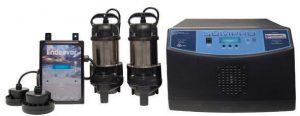Keep Your Basement Dry This Spring
Living in Winnetka, we all know the 100 Year Flood likes to descend on us more frequently than once a century, so making sure your home is outfitted with working flood prevention systems is the best way to avoid a wet basement when the rain comes.
Some easy tips include keeping your gutters clear and installing downspout extensions to direct rainwater away from the building’s foundation. You will also want to make sure your landscaping is graded to slope away from your home on all sides. Also, place a dehumidifier in your basement and connect it to the floor drain via a garden hose. Be sure to check the drain regularly to make sure it remains unclogged and pour hot water into the drain periodically to keep it open and control algae growth.
Finally, if you don’t already have a sump pump, install a sump pump with a battery-operated backup. Installation of a sump pump involves building a connection to a drainage system, so initially this is a bigger project done by a professional. Once the sump pump system is in place, annual maintenance of your system is recommended to offer your home the best protection against water incidents.
There are many different sump pumps on the market but the typical and highly recommended set-up is a sump pump with a battery back-up. The battery back-up is a key component in the sump pump operations should the power go out or if there is a mechanical failure.
Which sump pump should you purchase?
There are two main types of sump pump you can choose between:
Pedestal pumps are sump pump systems which have an upright pump located on top of the water basin. These pumps are more efficient, but also tend to be louder and more
expensive. The benefit, though, to a pedestal pump is that it has a longer lifespan – with some offering a warranty of 10 years. A pedestal pump such as a Tramco Pump, can last as long as 20 years before needing to be replaced.
Submersible pumps are pumps that are placed in the bottom of the water basin and are submersed in the collected water. Once the water rises to a certain level within the basin, the pump is activated and pumps out the water. These types of pumps are commonly installed as they are less expensive; however, because the motor tends to be under water, they have
a shorter lifespan. The warranty on Zoeller brand submersible pumps is 3 years, and typically, submersible pumps need to be replaced every 5-7 years.
It is highly recommended that all sump pumps include a battery back-up system. This is a battery-operated back-up pump which will kick in should there be a power outage,
mechanical failure, or if the primary pump becomes overwhelmed by a large amount of water. The right battery back-up for your home’s system should have very high reserve capacity allowing the back-up system to work continuously for hours or intermittently for days, if necessary. To get the best performance out of your pump system, a back-up system should be in place and regular maintenance should be performed.
Additionally, exciting new technology has arrived in the sump pump industry! Metropolitan Industries offers a variety of pump control switches which provide digital level controls and alarm notification systems so homeowners are able to closely monitor pump status. The Ion line of switches is designed to operate one or two pumps, either alternating or simultaneously. The controller offers smart sensing technology that tracks critical information, including switch failure, pump amp draw, and water level. The Ion line also comes with an optional advanced
monitoring and alarm system through a wireless system.
The Sumpro auxiliary power source works in conjunction with the Ion system and can be used as either a primary or back-up pump. Both of these monitoring systems are capable of sending updates to the home owner via text alert with the installation of optional notification equipment. Whichever pump system you choose to replace your old one, take into consideration the value of having it installed by professionals. Keeping your basement dry is incredibly important, and regular maintenance is key to well-functioning pump systems.






